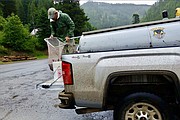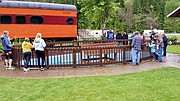Let there be fish!
Avery fishing pond restocked; tradition continues
AVERY — After a bit of a scare, the historic Avery fish pond in the middle of town has been restocked with fish.
On July 1, personnel with the Idaho Department of Fish and Game and the South Fork Trout Farm came to the small Shoshone County town and stocked the more than 100-year-old pond with 24 rainbow trout (minus one that died later on). IDFG provided 18 and the South Fork Trout Farm provided the other six.
Co-caretaker of the pond, Sanda Piccinini, explained that it wasn’t an easy path to getting the restock this year, but it was certainly worth it in the end.
Before Piccinini and other Avery residents could think about getting the fish, they first had to deal with repairing the structure.
“It had been repaired and worked on here and there over the years,” she said. “It had also been painted, but this time it needed some serious repair.”
Over the course of several days, the pond’s caretakers worked through adverse weather conditions to patch holes and hand paint the walls of the pond with special aquatic epoxy paint to seal it up tight.
Once repairs were complete, negotiations then had to be made with IDFG to get them to come restock the pond. Historically, the pond has almost always been stocked by IDFG (not counting the early years where it was stocked with fish right from the St. Joe River), but this time around, pond caretakers got some pushback. Thankfully though, everything was sorted out and IDFG delivered.
With the age and history of the place, it’s incredible that these were the only necessary repairs.
While Piccinini believes that the pond was constructed in 1909, before the great fire of 1910, her only photographic evidence puts it at a bit later than that.
“When I had to do the adjudication of the water for the pond for the state of Idaho, they needed a picture with a date on it. The date on the picture I sent them was 1912,” she said.
Whenever it was created, Piccinini explained that the reason it was built was for entertaining railroad passengers as they waited for the modern day equivalent of a layover flight.
Avery was once a bustling railroad hub on the Milwaukee Road that brought people from far and wide to the area, whether it be for work or just passing through.
“This was a turning spot for the electric engines, so when the electric engine was the only thing that could pull them out and come down into Avery from Montana, they would have passenger trains. The railroad needed something for the passengers to do while they unhooked the electric engine, took it down to the roundhouse, and brought up a disease engine to continue west. So they built the fish pond, put trout in it, and even built tennis courts next to it. That gave enough time for the passengers to get off, stretch and watch the fish. Many of them were from back east and had never seen a trout.”
Being directly tied to the railroads that were the lifeblood of this region in its developing years, the Avery fish pond is a popular attraction even to this day.
“When the Milwaukee Railroad came through here, there were no roads, so they had to build the track that came to Avery,” Piccinini said. “That’s how they got their supplies and everything else to town. At that time, you had immigrants coming into this country and they would hop the train. Because there was work here, putting the tracks down and the tunnels in. Avery would have people from all over the world.”
These immigrants from places like France, Italy, China and Japan would then put down temporary roots while they worked in the area and start families. Because of these original trailblazers, generations of families from numerous backgrounds make the trip to Avery to see the pond that they saw as a child or that their family members saw when they were young.
“People come from all over the world to see this fish pond because their parents or their grandparents were linked to this place,” Piccinini said.
The Avery fish pond is fed with water from Avery Creek and the fish who call it home traditionally live anywhere from 8 to 10 years. During the winter, caretakers allow the pond to freeze over and let the fish go dormant — just like they normally would if they were in the wild.
With another generation of fish inhabiting the pond, Piccinini and the rest of the Avery volunteers couldn’t be happier.
“It’s wonderful having new fish! The fish pond means a lot to a lot of people. Lots of memories,” she said.





